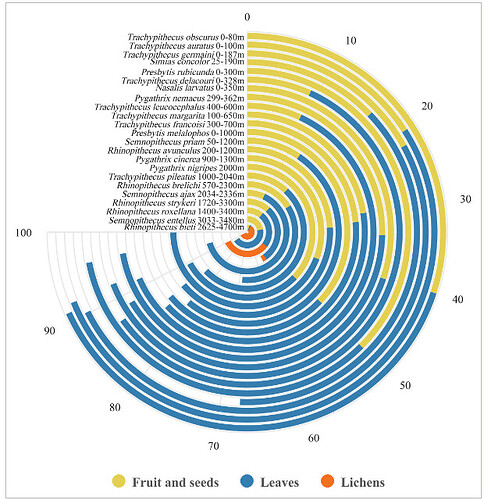Good day,
I am trying to create a race track plot similar to this:
I want to display the proportion of species for sites. And I am doing something wrong.
Thanks!
I created a dummy dataset with three sites, and four species. Proportions add up to 100%.
tibble::tribble(
~site, ~spp, ~prop,
"site1", "A", 80,
"site1", "B", 10,
"site1", "C", 5,
"site1", "D", 5,
"site2", "A", 50,
"site2", "B", 25,
"site2", "C", 25,
"site2", "D", 0,
"site3", "A", 75,
"site3", "B", 10,
"site3", "C", 10,
"site3", "D", 10
)
And my code:
rt$site <- as.factor(rt$site)
#> Error in rt$site: object of type 'closure' is not subsettable
rt$spp <- as.factor(rt$spp)
#> Error in rt$spp: object of type 'closure' is not subsettable
class(rt$prop)
#> Error in rt$prop: object of type 'closure' is not subsettable
rt$prop <- as.numeric(rt$prop)
#> Error in rt$prop: object of type 'closure' is not subsettable
plot5<- ggplot(rt, aes(x = site, y = prop,
fill = spp)) +
geom_bar(width = 0.9, stat="identity") +
coord_polar(theta = "y") +
xlab("") + ylab("") +
ylim(c(0,100)) +
ggtitle("Test for Species") +
geom_text(data = rt, hjust = 1, size = 3,
aes(x = site, y = 0, label = site)) +
theme_minimal() +
theme(legend.position = "right",
panel.grid.major = element_blank())#,
#> Error in ggplot(rt, aes(x = site, y = prop, fill = spp)): could not find function "ggplot"
# panel.grid.minor = element_blank(),
# axis.line = element_blank(),
# axis.text.y = element_blank(),
# axis.text.x = element_blank(),
# axis.ticks = element_blank())
plot5
#> Error in eval(expr, envir, enclos): object 'plot5' not found
Created on 2024-04-16 with reprex v2.1.0

